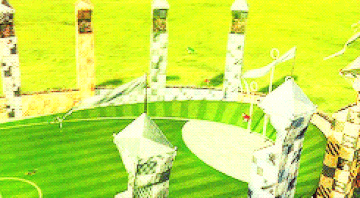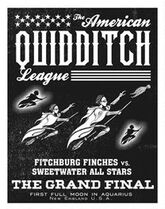- "Quidditch, the most popular sport in the magical world – highly dangerous, very exciting and played on broomsticks."
- — Description[src]
Quidditch (formerly known as Kwidditch and Cuaditch) was a wizarding sport played on flying broomsticks.[1] It was the most popular and well-known game among wizards and witches, and, according to Rubeus Hagrid, the wizard equivalent to Muggles' passion for football.
The game was played by two teams with seven members each. The object of the game was to score more points than the opposing team.
History
While Quidditch was the first (and so far, only) broomstick-based game to attain near-worldwide popularity amongst the wizarding people, it was certainly not the first broomstick game. In truth, Quidditch probably owed a debt to a number of its forerunners in making it as successful as it became.
All of these archaic broom games were popular in localised areas, but none had the vast appeal that Quidditch did. The beauty of Quidditch was that it took the best aspects of all its predecessors, added its own unique twists, and ended up as a game that would remain popular with the masses for centuries.[1]
Ancient predecessors
The main ancient games that provided some inspiration for Quidditch were:

A game by the name of Stichstock originated in Germany and consisted of a single wizard acting as a guardian or goalkeeper, trying to protect an inflated dragon bladder. A number of other players mounted on broomsticks would attempt to pierce the bladder, with the first who successfully did so being declared the winner.[3] This game may have been the inspiration for the Quidditch position of Keeper.
An Irish game by the name of Aingingein required broomstick-mounted players to fly through a number of burning barrels set in the air, whilst all the time clutching a ball with one hand. At the end of this fiery course was a goal which the ball had to be hurled into. The wizard who completed the course and scored a goal in the shortest time was the winner.[3]
Creaothceann was an exceptionally violent and often fatal game that originated in Scotland. A large number of boulders were charmed to hover in the air and each player had a cauldron strapped to his/her head. A horn was sounded, the rocks were released, and the players would fly around on their broomsticks trying to catch as many rocks in their cauldron as possible. The winner was the player who caught the most rocks (this game has been outlawed for many years).[3] This game, as noted in Quidditch Through the Ages, was thought to be the inspiration of the Beater position.

Shuntbumps was a very simple form of broomstick-jousting where one flyer attempts to knock the others off of their broom.[3]
A game rather like Tennis on a broomstick, Swivenhodge involved hitting an inflated pig's bladder backwards and forwards across a hedge.[3] This game could have been the inspiration of the Quidditch position of Chaser, simply because it was the first and only mentioned broom game involving a ball being passed, barring Quidditch itself.
Evolution of the game
The sport of Quidditch got its name from Queerditch Marsh, the location of the first ever recorded game. A witch by the name of Gertie Keddle lived on the edge of the marsh around the year 1050 and recorded what she saw in a diary that survives to this day. Successive entries in her journal show the evolution of the game and how each element was introduced.[1]
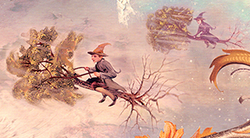
Her first note simply recorded her annoyance at a number of people playing a game with a ball whilst flying their broomsticks above the marsh. When the ball landed in her cabbage patch, she confiscated it and then hexed the man who asked for it.[1]
A second entry showed that the players did not give up, but had made themselves a new ball and were then trying to score goals by throwing it through trees at the end of the marsh. This was the earliest incarnation of the Quaffle and the scoring hoops.[1]
The third entry noted the introduction of flying rocks that had been bewitched to knock the players off their broomsticks, which were the forerunners of the Bludgers. She also mentioned the presence of a 'big Scottish warlock' who may have been a Creaothceann player, which would show a clear link between the two sports.[1]
With historical records of the time being rather limited, there was no further mention of Quidditch until a hundred years later, around 1150. A letter sent from a wizard called Goodwin Kneen to his Norwegian cousin Olaf survived from this time and gave a clear indication of how far the game had come. It had gained a name (although it was spelt 'Kwidditch' at this time) and a number of organised teams, as well as titles for players and equipment. From the letter it can be seen that early Chasers were known as 'Catchers', and the Bludger began its life as the 'Blooder'.[1]
Kneen's letter also revealed a new innovation: using three barrels mounted on stilts to use as the goals. This was undoubtedly a massive improvement from using trees as the goals and is a clear precursor to the hoops used in the modern game. Therefore it can be seen that the sport of 'Kwidditch' played by Kneen was already very similar to what Quidditch came to be.[1]
The one missing element was the Golden Snitch.[1]
Golden Snitch
- "This... is the Golden Snitch, and it's the most important ball of the lot. It's very hard to catch because it's so fast and difficult to see. It's the Seeker's job to catch it. You've got to weave in and out of the Chasers, Beaters, Bludgers, and Quaffle to get it before the other team's Seeker, because whichever Seeker catches the Snitch wins his team an extra hundred and fifty points, so they nearly always win. That's why Seekers get fouled so much. A game of Quidditch only ends when the Snitch is caught, so it can go on for ages —"
- — Description of the Snitch and a Seeker's job[src]
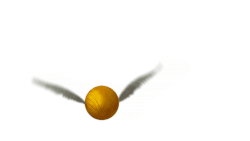
The history of the Snitch was perhaps the most interesting of all the Quidditch balls, and its introduction came as the direct result of a game played in 1269 in Kent. This was over a century on from Goodwin Kneen's letter to his cousin, and it seems that during this time, the game had acquired a great deal of popularity and organisation, and had altered in its format very little. It was, however, now routinely attended by large crowds of people who wanted to watch the game.[1]
The 1269 game mentioned above was attended by Barberus Bragge, the Chief of the Wizards' Council. As a nod to the sport of Snidget-hunting, which was also popular at the time, Bragge brought such a bird to the game and released it from its cage. He told the players that one-hundred and fifty Galleons — a large sum of money, particularly in those times — would be awarded to the player who caught the bird.[1]
This was easier said than done: the Snidget was very fast, very small, and could make sudden changes of direction at high speeds. The considerable challenge posed by the flight patterns of the bird was what made Snidget-hunting so popular in the first place.[1]
What happened at the Quidditch game in question was rather predictable: the players totally ignored the game, and each and every one simply went off in pursuit of the Snidget, which was kept within the arena by the crowd using Repelling Charms.[1]

A witch named Modesty Rabnott, who was also watching the game, took pity on the Snidget and rescued it with a Summoning Charm before rushing away with it hidden inside her robes. She was caught by a furious Bragge and fined ten Galleons for disrupting the game, but not before she had released the Snidget.
This saved the life of this bird, but the connection with Quidditch had been made, and soon a Snidget was being released at every game. From then, each team had an extra player — originally called the Hunter, later the Seeker — whose sole job was to catch and kill the Snidget, for which one-hundred and fifty points were awarded in memory of the one-hundred and fifty Galleons offered by Bragge in the original game.[1]
The vast popularity of the sport led to quickly declining Snidget numbers, and in the middle of the 14th century it was made a protected species by the Wizards Council, now headed by Elfrida Clagg. This meant that the bird could no longer be used for Quidditch purposes, and indeed the Modesty Rabnott Snidget Reservation was created in Somerset to safeguard the Snidget's future survival.[1]
The game of Quidditch, however, could not continue without a substitute.[1]
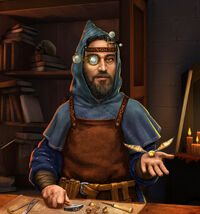
Whilst most people looked for a suitable alternative bird to chase, Bowman Wright, a metal-charmer from Godric's Hollow had a different idea: he invented a fake Snidget which he called the Golden Snitch. His invention was pretty much what was seen on the modern Quidditch pitch: a golden ball with silver wings, the same size and weight as a real Snidget, bewitched to accurately follow its flight patterns. An additional benefit was that the ball was also charmed to stay within the playing area, removing the need for the continual use of Repelling Charms by the crowd.[1]
The Snitch was approved as a Snidget substitute, the game of Quidditch could continue, and the modern sport as we know it was complete. All of the balls used in the modern game were now present, organised teams played against each other, and vast numbers of people came to watch. Whilst this may sound exactly like the sport as it came to be, there were still a few modifications to be made in terms of the playing pitch, and this continued to evolve until 1883 when the format of modern Quidditch pitches was finalised.[1]
Match overview
- " Mount your brooms, please.' Harry clambered onto his Nimbus Two Thousand. Madam Hooch gave a loud blast on her silver whistle. Fifteen brooms rose up, high, high into the air. They were off."
- — The start of a 1991 Gryffindor vs. Slytherin match[src]
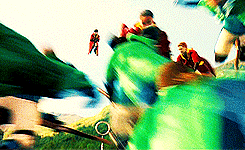
There were seven players on a Quidditch team: three Chasers, two Beaters, one Keeper, and one Seeker. The game was played with four balls: a Quaffle, two Bludgers, and a Golden Snitch.
The Chasers handled the Quaffle and earned points by tossing it through any one of a set of three goalposts on the opposing teams side of the field. Each goal was worth 10 points. The Keeper guarded the goalposts in an effort to prevent the opposing teams Chasers from scoring.
The Seeker tried to catch the Golden Snitch before the opposing team's Seeker could. The Golden Snitch flew very fast and was difficult to see. When and only when the Snitch was caught did the game end, and the Seeker who caught the Snitch earned 150 points for their team.
The two Bludgers were highly aggressive balls that flew through the air and tried to knock the players off their broomsticks. The two Beaters each used a bat to hit the Bludgers in an effort to keep them away from their own teammates, as well as to send the Bludgers towards the members of the opposing team.[2]
The game started with the referee releasing all four balls from the central circle on the field. The Bludgers and Snitch were bewitched to fly off of their own accord, but the Quaffle was thrown into the air by the referee to signal the start of play (This is similar to how the games of basketball and Gaelic football, popular Muggle sports, begin by the referee throwing the ball in the air).[2]
After a goal was scored, the opposing team's Keeper would throw the Quaffle back into play.[2] Teams continued using the same goalposts to score throughout the game.

The game only ended when the Golden Snitch was caught, or if the Captains of both teams managed to reach an agreement. Some games could go on for many days if the Snitch was not caught (the record for the longest game, according to Quidditch Through the Ages, was six months, although no one caught the Snitch). Since the lengths of Quidditch games were variable (some games could go on for days if the Golden Snitch was not caught) the game was not played in periods, although captains could call for a time out.[1]
The winner of the game was the team with the most points, regardless of who caught the Golden Snitch.[2] Catching the Golden Snitch was worth 150 points to the team whose Seeker made the catch, but this did not necessarily mean they would win, as the other team could still have more points after the Snitch was caught (i.e. if the other team had at least 160 more points when the Snitch was caught). As a result, it was possible, although difficult, to win the game even though the opposing team caught the Snitch, as was the case of the final match between Ireland and Bulgaria of the 1994 Quidditch World Cup.[4]
The Snitch was bewitched to respond to the first witch or wizard to make contact with it, in case there was any dispute regarding which Seeker touched it first. Despite this, there have been several instances in which the Snitch has been fumbled.
It was never explained what happened in the event of a tie.
Committees

The International Confederation of Wizards' Quidditch Committee was an international regulatory body, subject to the International Confederation of Wizards, that oversaw international Quidditch competitions, such as the World Cup. Namely, it located suitable venues, arranged transportation for spectators, and provided policing for the games themselves. It was also the ICWQC that chose the referees for World Cup matches.
Quidditch was governed in Britain by the Department of Magical Games and Sports, where the British and Irish Quidditch League Headquarters was situated.[1]
Quidditch pitches
- "Zacharias Mumps describes the fourteenth-century pitch as oval-shaped, five hundred feet long and a hundred and eighty feet wide with a small central circle (approximately two feet in diameter) in the middle."
- — The fourteenth-century pitch[src]
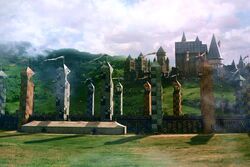
Quidditch pitches were typically in the shape of an oval, five-hundred feet long and one-hundred and eighty feet wide, with a small central circle of approximately two feet in diameter, from which all the balls were released at the start of the game. At each end there were three hooped goal posts of different heights, surrounded by a scoring area.
As Quidditch is an aerial sport, Quidditch pitches usually feature spectator seating at high vantage points, whether in towers (such as at Hogwarts) or in a fully-encircling platform style (such as the British stadium that held the 1994 Quidditch World Cup).[1]
The three hooped goal posts were originally barrel-goals, introduced during Goodwin Kneen's time. At the time of the introduction of the scoring area, they were replaced by baskets on stilts, but whilst these were practical, they did carry an inherent problem: there was no size restriction on the baskets, which differed dramatically from pitch to pitch.[1]
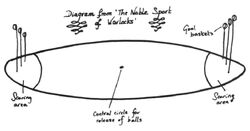
By 1620, scoring areas had been added at each end of the pitch, and an additional rule in the game, a 'stooging penalty', meant that only one Chaser was allowed in these areas at any given time, as noted in Quintius Umfraville's book The Noble Sport of Warlocks. In addition, the size of the baskets themselves had reduced considerably, although there was still a certain amount of variation between pitches.
Regulations were finally introduced in 1883 which replaced the baskets with hoops of a fixed size, and the modern Quidditch pitch was complete. Both these changes caused a considerable amount of controversy, which resulted in riots and threats against the Minister.[1]
Quidditch pitches were built in places where they would not attract Muggle attention. This began in 1398 when the wizard Zacharias Mumps emphasised the need for anti-Muggle security while playing the game: 'Choose areas of deserted moorland far from Muggle habitations and make sure that you cannot be seen once you take off on your brooms. Muggle-repelling charms are useful if you are setting up a permanent pitch. It is advisable, too, to play at night.' The advice of Mumps must not have always been followed, as in 1362, the Wizards' Council outlawed playing Quidditch within fifty miles of a known Muggle town.
This was amended in 1368, possibly due to growing popularity of the game. This amendment made the playing of the sport within one-hundred miles of a Muggle town illegal, famously worded as not to play 'anywhere near any place where there is the slightest chance a Muggle is watching, or we'll see how well you can play while chained to a dungeon wall.'[1]
The International Statute of Wizarding Secrecy of 1692 made all Ministries of Magic responsible for the consequences of magical sports in their territories. The Department of Magical Games and Sports was created for this purpose. Quidditch teams that flouted Ministry guidelines were disbanded. One such instance was the Banchory Bangers.[1]
Quidditch events
Quidditch World Cup
- "A source of vehement disagreements, a security risk for all who attend it and a frequent focus for unrest and protest, the Quidditch World Cup is simultaneously the most exhilarating sporting event on earth and a logistical nightmare for the host nation."
- — Description of the Quidditch World Cup[src]

The Quidditch World Cup[5] was held every four years since 1473. The competition saw Quidditch teams representing countries around the world to compete for the World Cup, while the International Quidditch Tournament was between regional teams.
The Official Guide to the Quidditch World Cup was the official guidebook to the Quidditch World Cup, written and published by the International Confederation of Wizards' Quidditch Committee, providing information on the rules and history of the Quidditch World Cup. Sold in most reputable bookstores, this tome cost thirty-nine Galleons, leading most wizards and witches to call it overpriced.[6]
As with so much else about the wizarding world’s most important sporting competition, many queried the accuracy of this statement. As only European teams competed during the fifteenth and sixteenth centuries, purists preferred to date the Quidditch World Cup’s inception from the seventeenth century when it became open to all continents.[6]
There was also heated debate about the accuracy of some historical accounts of tournaments. A substantial amount of all post-game analysis centred on whether magical interference took place and whether it made, or ought to have made, the final result moot.[6]
Inter-House Quidditch Cup
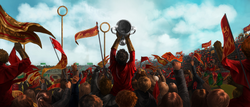
The Inter-House Quidditch Cup was a championship that took the form of a mini-league at Hogwarts School of Witchcraft and Wizardry. Each house team played each other throughout the course of the school year. This resulted in three games for each team, and six games of Quidditch for the school to enjoy overall.
Final standings in the competition were based on the total amount of points won over all matches played, rather than the number of victories. It was entirely possible for one team to lose to another, but still claim the Cup if their points from previous games had been high enough.
The Quidditch Cup itself was an enormous, silver trophy cup, with four handles designed after the four Houses' emblematic animals. The Cup was traditionally kept in the office of the reigning champions' Head of House.
Equipment
Before the game could start, every player had to have a few standard things. Each player had to have a Broomstick between their legs. As protection, they had to wear a Quidditch helmet, Goggles, shin, knee and arm guards, and gloves. The different Quidditch positions required different equipment.
For example, Beaters carried bats and Keepers wore protective head and chest gear. Each player had to wear the uniform of their team in an official match, so they could see who is with who. A uniform consisted of a cape and jersey. Each team's robes had their own colours and either logos or insignia. They had a special meaning to the team and their fans.[2]
Most of the players in Great Britain bought their equipment at Quality Quidditch Supplies, in Diagon Alley, London.[7]
The game was played with three types of balls: the Golden Snitch, Quaffle and Bludger.[2]
Rules
The worldwide popularity and playing of the game of Quidditch was closely monitored and analysed by the International Confederation of Wizards' Quidditch Committee.[1]
In 1750, the British Ministry of Magic set down official rules for the game of Quidditch.
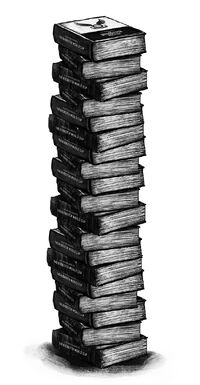
| 1. | Players must not stray over the boundary lines of the pitch, although they may fly as high as desired. The Quaffle must be surrendered to the opposition if any player leaves the boundary (it is unknown what the penalty is if a player on defence leaves the pitch).[1] |
| 2. | 'Time out' may be called at any time by the Captain of a team. Time out may be extended to two hours if a game has already lasted for more than twelve hours. Failure to return to the pitch after this time will lead to the team being disqualified.[1] |
| 3. | Penalties can be awarded to teams by the referee. A single Chaser may take the penalty by flying from the central circle towards the scoring area. The opposing team's Keeper may attempt to stop the shot being scored, but all other players must not interfere (it is unknown if the Seeker may still attempt to catch the Snitch while a penalty is being attempted).[1] |
| 4. | Contact is allowed, but a player may not seize hold of another player's broomstick or any part of their anatomy.[1] |
| 5. | No substitution of players is allowed throughout the game, even if a player is too injured or tired to continue to play. (Note: According to Goblet of Fire, during the Quidditch World Cup, at some point it lasted for days, and the players had to be switched out so that they could get some sleep).[1] |
| 6. | Players may take their wands onto the pitch, but they must not be used on or against any players, any players' broomsticks, the referee, any of the four balls, or the spectators.[1] |
| 7. | A game of Quidditch will only end once the Golden Snitch has been caught, or at the mutual consent of both team Captains.[1] |
| 8. | Only the Keeper can block quaffle shots thrown by the opposing team.[1] |
| 9. | Beaters are not allowed to send the Bludger's toward the Keeper unless the Quaffle is inside the scoring area.[8] |
An amendment to the rules of Quidditch in 1849 determined that if a member of the crowd cast any spell on a player, their team would automatically forfeit the match, whether or not the team ordered or approved of the magic performed.[9] (It is not clear how this was enforced, though, as taken literally, this rule would make it even easier to sabotage an opposing team with a false-flag attack).
Fouls
There were seven hundred Quidditch fouls listed in the Department of Magical Games and Sports records, though the entire list was never made public (it was the department's view that some wizards and witches 'might get ideas'). 90% of these were banned anyway, by the rule concerning wand use against the opposing team (or rather, lack thereof) and the remaining 10% would not occur even to the dirtiest player.[1] There were, however, 11 common fouls, named below (names of those to whom the fouls applied in brackets):






|
During the final of the 1473 Quidditch World Cup, all seven hundred fouls were committed. These naturally included all 11 aforementioned as well as:
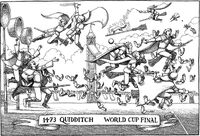
- Transfiguring of a Chaser into a polecat.
- Attempted decapitation of a keeper with a broadsword.
- The release of one hundred blood-sucking vampire bats from under the Transylvanian Captain's robes during the game.
- Setting fire to an opponent's broom tail.
- Attacking an opponent's broom with a club.
- Attacking an opponent with an axe.
Tactics and moves
Over the centuries, many difficult and entertaining moves were invented by players who constantly pushed themselves and the game as far as they could go. Among them were:











|
|
Quaffle throws
|
|
Quidditch titles
|
Cups: |
Known Quidditch teams

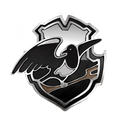
Publications
Books
Magazines
Fans
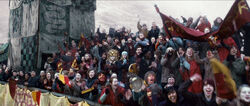
Quidditch was a hugely popular spectator sport. One hundred thousand fans attended the 1994 Quidditch World Cup final. Binoculars and Omnioculars were sometimes used by fans to view matches from the stands.[4]
At Hogwarts School of Witchcraft and Wizardry, there was such a small number of games, but each one was eagerly anticipated and usually attended by the entire school, including the teachers. When it came to Quidditch some of the Professors lost their normal calm demeanour and became as excited about the result as the students.
British Quidditch fans kept up to date with the latest Quidditch news in the Daily Prophet and Seeker Weekly.[19]
Fans could buy a wide range of team merchandise including hats, scarves, flags, jerseys, badges and figurines.[4]
Behind the scenes
- There is a game based on Quidditch called Muggle Quidditch in the real world.
- The name 'The Noble Sport of Warlocks' may be a reference to horse racing being called 'The Sport of Kings'.
- The fact that some of the fouls are so specific suggests that the behaviour during the 1473 Quidditch World Cup was so egregious that new fouls were created specifically to cover everything that happened.
- There are some differences between how Quidditch is represented in Kennilworthy Whisp's Quidditch Through the Ages (and the books) and how it appears to be played in the films and video games.
- Most notably in the films, the rule that players must not stray outside the pitch boundary is not evident, as players can be seen flying around the spectator towers at the Hogwarts Quidditch pitch, as well as the scene where the rogue bludger chases Harry and Malfoy around the outside of the pitch boundaries in the film adaptation of Harry Potter and the Chamber of Secrets.
- The balls also show notable differences. Quidditch Through the Ages shows us that the Quaffle is a perfect sphere, but the movie and games' versions have four large indentations around its surface. In addition, the Bludgers in Quidditch Through the Ages are ten inches in diameter, two inches smaller than the Quaffle. In the movies and games, however, they appear much smaller than the Quaffle.
- There also seems to be more allowance for malicious acts in the films, as we see several instances where Slytherin players physically attack the opposition with no penalty.
- In the video game Harry Potter: Quidditch World Cup, the rule of only having a single Chaser in the scoring area is not used. Additionally, the game allows for players to make special moves where by several goals are scored in succession as multiple Chasers pass the Quaffle back and forwards through the hoops.
- Quidditch Through the Ages states that the Keeper cannot block goals from behind the goal post, so it would be impossible for the Keeper to block without a foul towards his/her team. This would most likely represent a foul towards the offensive team.
- Also in the films, there have been funny moments in Quidditch, for example in the film adaptation of Harry Potter and the Philosopher's Stone, Oliver Wood kicks the Quaffle into the air and grabs it on the backside of the hoop when defending it, and in the film adaptation of Harry Potter and the Half-Blood Prince, when Ginny Weasley scores 10 points, a Slytherin Chaser and the Slytherin Keeper collide and then collapses into the hoop.
- Quidditch was omitted from the film adaptation of Harry Potter and the Order of the Phoenix, and Ronald Weasley became the Gryffindor keeper in the film adaptation of Harry Potter and the Half-Blood Prince instead. In the Order of the Phoenix film, Dolores Umbridge, in her capacity as Hogwarts High Inquisitor, created Educational Decree Number Forty-Nine, which stated that 'All Quidditch matches are hereby cancelled. Broomsticks will be turned in to the High Inquisitor for safe keeping.'
- J. K. Rowling wrote five pages of words starting with 'Q' before deciding upon 'Quidditch'.[20]
- J. K. Rowling first developed Quidditch after a fight with her boyfriend at the time in a small hotel in Manchester. Some of the game's elements, such as the Golden Snitch being worth a disproportionate amount of points, were due to her state of mind at the time, as she felt these elements would be frustrating to men.[21]
- Matthew Lewis has said that he would like to be a professional Quidditch player.[22]
- In Harry Potter: Quidditch Champions, Quidditch teams feature teams fewer than seven members, a contradiction to the established lore, because it would generate enormous demands in performance. J. K. Rowling allowed it.[23]
Appearances
- Harry Potter and the Philosopher's Stone (First appearance)
- Harry Potter and the Philosopher's Stone (film)
- Harry Potter and the Philosopher's Stone (video game)
- Harry Potter and the Chamber of Secrets
- Harry Potter and the Chamber of Secrets (film)
- Harry Potter and the Chamber of Secrets (video game)
- Harry Potter and the Prisoner of Azkaban
- Harry Potter and the Prisoner of Azkaban (film)
- Harry Potter and the Prisoner of Azkaban (video game)
- Harry Potter and the Goblet of Fire
- Harry Potter and the Goblet of Fire (film)
- Harry Potter and the Order of the Phoenix
- Harry Potter and the Order of the Phoenix (video game) (Mentioned only)
- Harry Potter and the Half-Blood Prince
- Harry Potter and the Half-Blood Prince (film)
- Harry Potter and the Half-Blood Prince (video game)
- Harry Potter and the Deathly Hallows (Mentioned only)
- Harry Potter and the Deathly Hallows: Part 1 (Daily Prophet)
- Harry Potter and the Cursed Child (Mentioned only)
- Harry Potter and the Cursed Child (play) (Mentioned only)
- Fantastic Beasts: The Crimes of Grindelwald
- Fantastic Beasts: The Secrets of Dumbledore
- Quidditch Through the Ages
- Harry Potter: A Pop-Up Book
- Harry Potter: Quidditch World Cup
- LEGO Harry Potter: Building the Magical World
- LEGO Harry Potter: Characters of the Magical World
- LEGO Dimensions
- LEGO Harry Potter: Years 1-4
- LEGO Harry Potter: Years 5-7
- LEGO Harry Potter
- Harry Potter and the Forbidden Journey
- Harry Potter Film Wizardry
- The Making of Harry Potter
- Harry Potter Trading Card Game
- Pottermore
- Harry Potter (website)
- Harry Potter for Kinect
- Harry Potter: The Character Vault
- Harry Potter: The Creature Vault (Mentioned only)
- Harry Potter: Hogwarts Mystery
- Harry Potter: Wizards Unite (Mentioned only)
- Harry Potter: Puzzles & Spells
- Harry Potter: Magic Awakened
- Hogwarts Legacy (Mentioned only)
- Harry Potter: Quidditch Champions
- The Harry Potter Wizarding Almanac
- The Art of Harry Potter: Mini Book of Graphic Design
Notes and references
- ↑ 1.00 1.01 1.02 1.03 1.04 1.05 1.06 1.07 1.08 1.09 1.10 1.11 1.12 1.13 1.14 1.15 1.16 1.17 1.18 1.19 1.20 1.21 1.22 1.23 1.24 1.25 1.26 1.27 1.28 1.29 1.30 1.31 1.32 1.33 1.34 1.35 1.36 1.37 1.38 1.39 1.40 1.41 1.42 Quidditch Through the Ages
- ↑ 2.0 2.1 2.2 2.3 2.4 2.5 2.6 2.7 2.8 2.9 Harry Potter and the Philosopher's Stone, Chapter 11 (Quidditch)
- ↑ 3.0 3.1 3.2 3.3 3.4 Harry Potter Lexicon - Games & Sports
- ↑ 4.0 4.1 4.2 4.3 4.4 Harry Potter and the Goblet of Fire, Chapter 8 (The Quidditch World Cup)
- ↑ Harry Potter and the Prisoner of Azkaban, Chapter 13 (Gryffindor versus Ravenclaw)
- ↑ 6.00 6.01 6.02 6.03 6.04 6.05 6.06 6.07 6.08 6.09 6.10 6.11 6.12 6.13 6.14 6.15 6.16 6.17 6.18 6.19 6.20 6.21 6.22 History of the Quidditch World Cup from Pottermore (via The Internet Archive)
- ↑ Harry Potter and the Philosopher's Stone, Chapter 5 (Diagon Alley)
- ↑ Harry Potter and the Prisoner of Azkaban, Chapter 15 (The Quidditch Final)
- ↑ Pottermore - USA VERSUS JAMAICA (I) (Archived)
- ↑ 10.0 10.1 10.2 Harry Potter: Wizards Unite
- ↑ Fantastic Beasts: The Crimes of Grindelwald (see this image) - "Le mystère de Bladger effraie la ligue de Grenoble"
- ↑ Daily Prophet Newsletters
- ↑ 13.0 13.1 13.2 13.3 13.4 13.5 13.6 Harry Potter: Quidditch World Cup
- ↑ 14.0 14.1 14.2 14.3 14.4 14.5 Harry Potter and the Goblet of Fire, Chapter 5 (Weasley's Wizard Wheezes)
- ↑ 15.0 15.1 (see this image)
- ↑ Harry Potter: Quidditch World Cup (concept art)
- ↑ Harry Potter and the Goblet of Fire, Chapter 30 (The Pensieve)
- ↑ A portrait of Selina Sapworthy, on exhibit as part of the Train Harry Potter et le Prince de Sang-Mêlé tour in France in 2009.
- ↑ Harry Potter and the Goblet of Fire (film)
- ↑ J.K. Rowling on The Diane Rehm Show, WAMU Radio Washington, D.C., October 20, 1999
- ↑ J.K. Rowling, Harry Potter and the Philosopher's Stone - with annotations, The Guardian
- ↑ https://www.pottermore.com/news/what-wizarding-world-jobs-would-the-harry-potter-cast-members-have
- ↑ an Warner Bros. Uncancel J.K. Rowling?
| Game of Quidditch | |||
|---|---|---|---|
 | |||
| Officials: Quidditch referee | |||
| Player positions: Beater • Chaser • Keeper • Seeker | |||
| Playing equipment: Beater's bat • Bludger • Broomstick • Golden Snitch • Quaffle | |||
